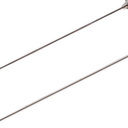Evaluation of structural and secretory glycoconjugates in normal human jejunum by means of lectin histochemistry.
Keywords
Abstract
The labelling pattern of eight lectins was studied in jejunal samples from ten normal subjects, in order to define the normal distribution of structural and secretory glycoconjugates in the small bowel. The following lectins were studied by means of a peroxidase technique on formalin-fixed samples: Arachis hypogaea, Ricinus communis, Canavalia ensiformis, Lens culinaris, Phaseolus vulgaris, Triticum vulgaris, Ulex europaeus, Dolichos biflorus. Phaseolus vulgaris reacted with goblet cell mucus throughout the villus-crypt axis. Conversely Ulex europaeus, Dolichos biflorus and Triticum vulgaris lectin labelling of goblet cells appeared to be confined to the upper part of the villi. This finding suggests that during cell migration from crypt to villus tip, the continuing maturation of goblet cells is associated with the differentiation of secretory carbohydrates, which probably parallels the cell maturation cycle. Lectin histochemistry appears to be a reliable tool for the study of structural and secretory glycoconjugates in the jejunal mucosa, and might be of value in the study of diseases in which the cell-maturation cycle in the small bowel is altered.


